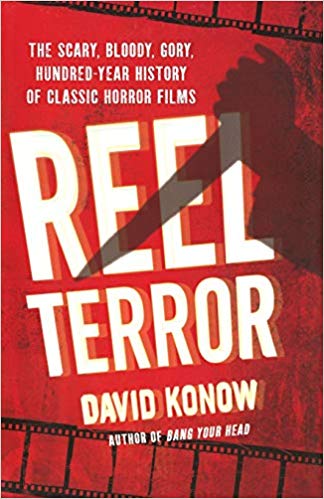 By DAVID KONOW (Thomas Dunne Books; 2012)
By DAVID KONOW (Thomas Dunne Books; 2012)
I’ll give this volume, in which author David Konow attempts to chronicle the entire 100-plus year history of horror cinema, points for ambition. I’ll also give Konow a nod for keeping his facts straight, since, speaking as one who knows a bit about classic and current horror cinema, I didn’t detect too many factual errors (although I would question the manner in which Konow presents his facts—see below). Unfortunately, those are about the only nice things I can say about this book.
REEL CINEMA’S biggest failing? Simply that the history of horror cinema cannot be adequately chronicled in this book’s 536 pages. Quite a few essential movies and trends are mentioned, with immortal films like FRANKENSTEIN, DRACULA, THE EXORCIST, HALLOWEEN, ALIEN, THE EVIL DEAD, THE SILENCE OF THE LAMBS and THE BLAIR WITCH PROJECT covered with a fair amount of info on the films’ making and reception, yet just as much is left out of this book. The AIP drive-in movies of the fifties and sixties are mentioned only in passing, as are the grindhouse pictures of the seventies and virtually the entire genre output of the 00’s (an entire decade that Konow crams, rather unbelievably, into a perfunctory 7-page epilogue), while such classics as the 1910 FRANKENSTEIN, the Godzilla films, EYES WITHOUT A FACE, PEEPING TOM, CARNIVAL OF SOULS, LET’S SCARE JESSICA TO DEATH, BASKET CASE, CANDYMAN and SHAUN OF THE DEAD aren’t mentioned at all.
Other problems? The book is top-heavy with coverage on films from the 1970s and 80s, with comparatively little on the preceding sixty years or the proceeding twenty. As stated above, the facts Konow presents, gleaned from interviews and other books, are generally solid, but his presentation often leaves much to be desired—example: the depiction of the Italian genre maestros Mario Bava, Dario Argento and Lucio Fulci as a “troika,” which is, frankly, wrong (to fully do justice to the Italian horror movie scene and Bava, Argento and Fulci’s place in it would require the inclusion of fellow countrymen like Riccardo Frada, Umberto Lenzi, Ruggero Deodato, Lamberto Bava and many others).
Finally, and perhaps most grievously, I’ll have to complain about David Konow’s noticeably flat and listless prose style. A little more enthusiasm would have been welcome, as would some of the redeeming quirkiness of classic horror movie themed tomes like Drake Douglas’ HORROR, Kim Newman’s NIGHTMARE MOVIES and David J. Skal’s THE MONSTER SHOW. Those books admittedly share many of the same flaws that plague this one, but all are distinguished by a real sense of passion and audacity, qualities REEL TERROR sorely lacks.
